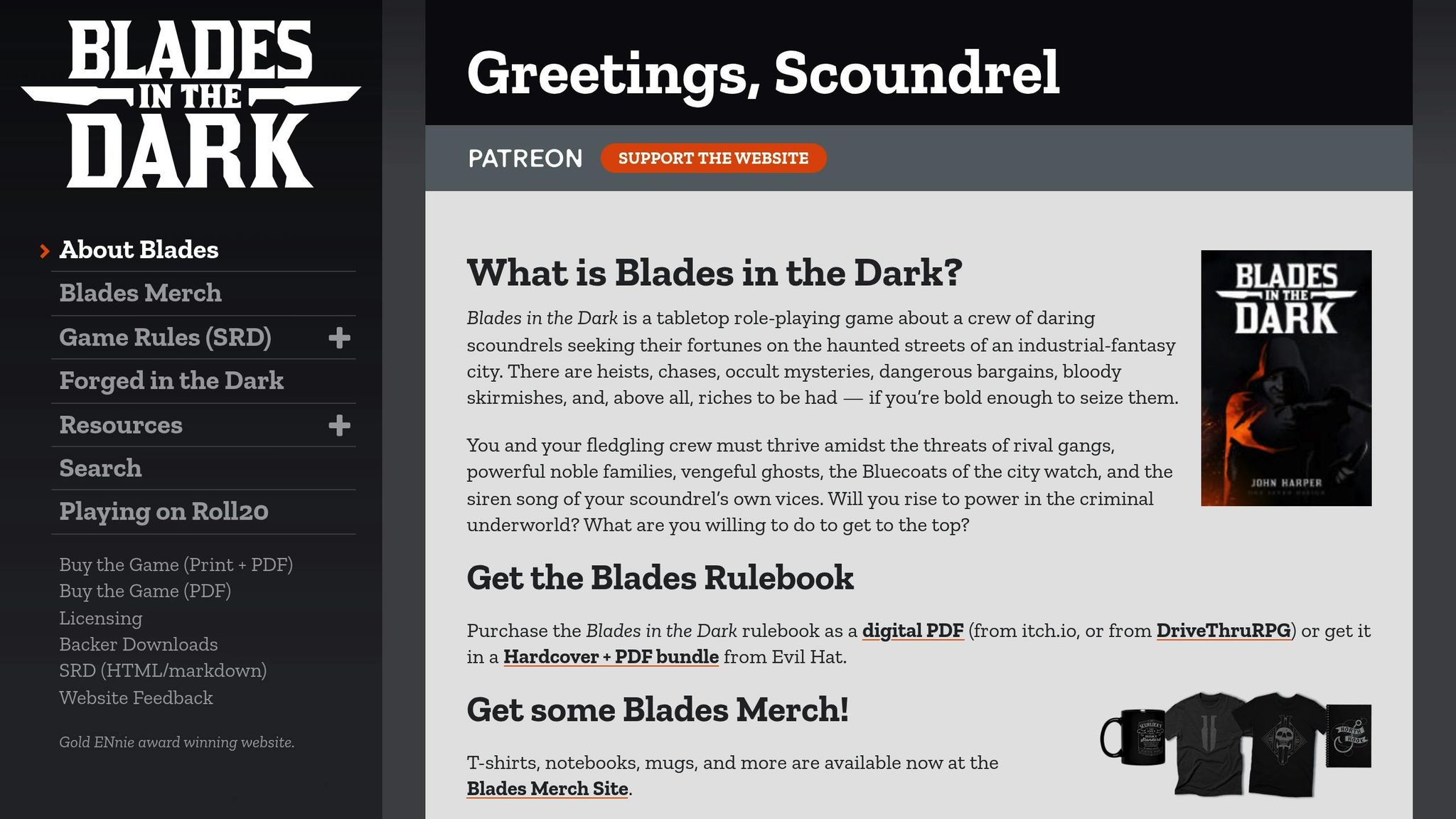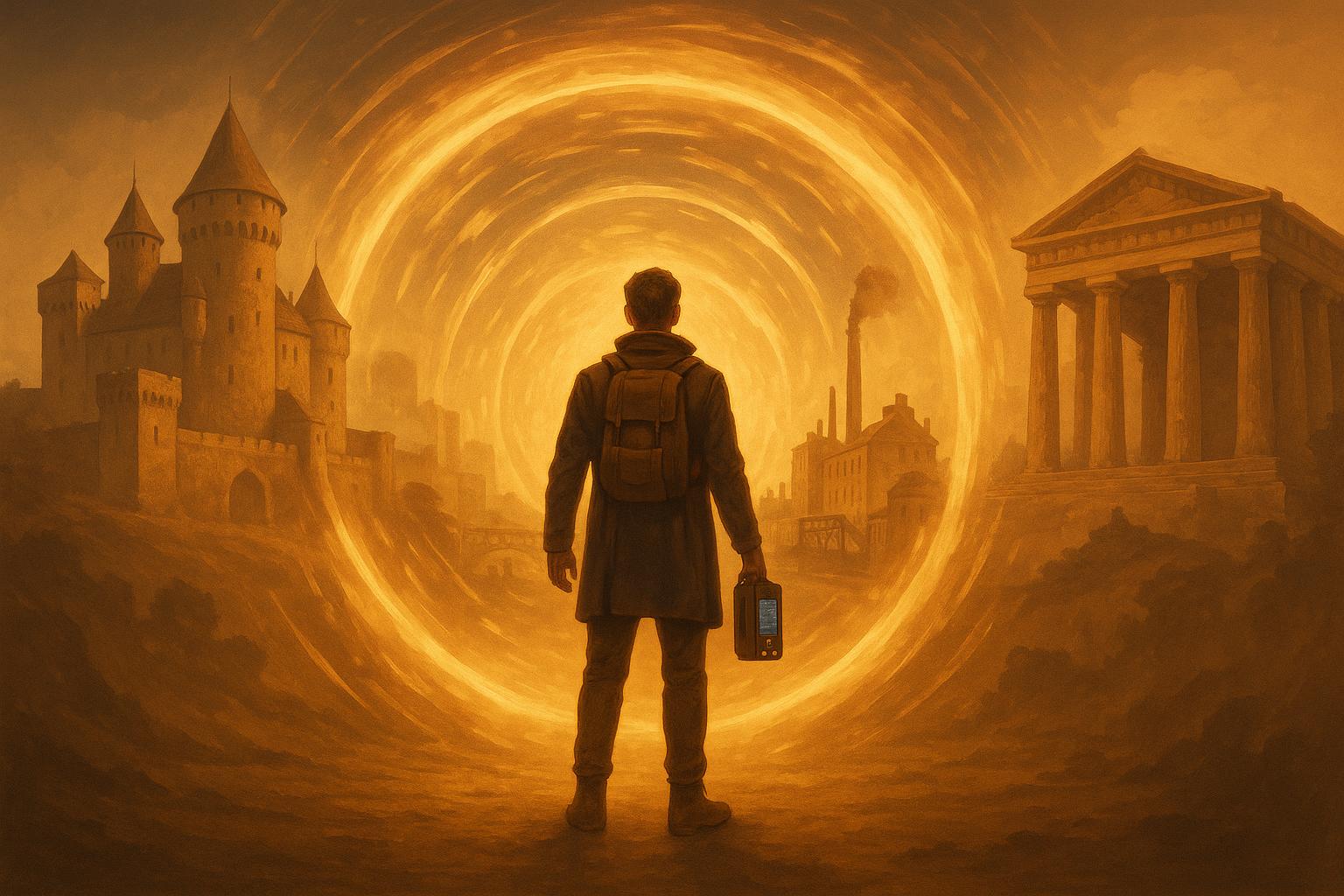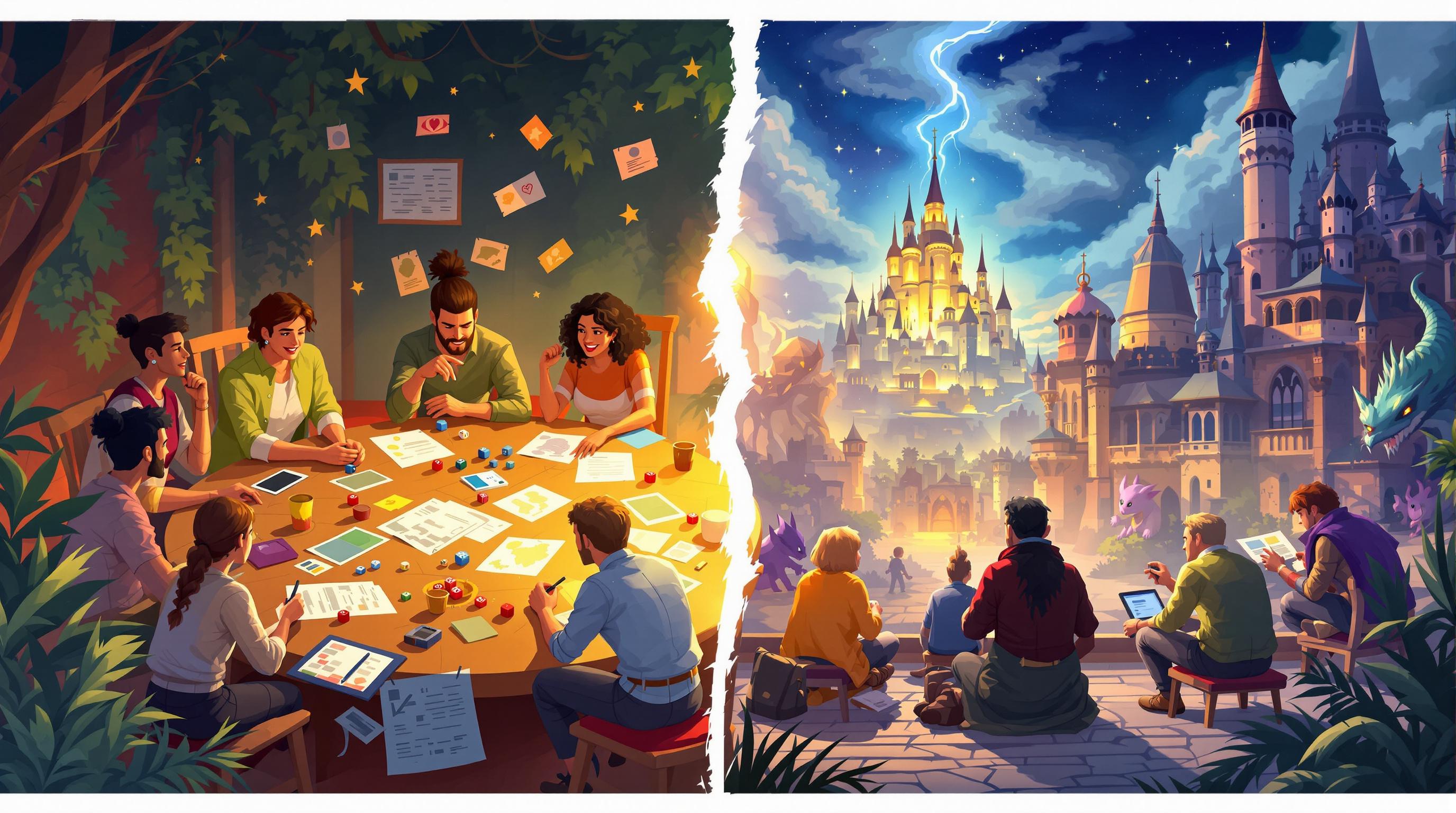Ironsworn and Blades in the Dark are standout tabletop RPGs that blend player decisions with chance through hybrid resolution systems. These mechanics balance strategy and unpredictability, offering unique ways to progress stories.
- Ironsworn uses a three-dice system (1d6 + stats vs. 2d10) for nuanced outcomes: strong hit, weak hit, or miss. It supports solo, co-op, and GM-led play, making it flexible for different group setups. Momentum adds a strategic layer, letting players influence critical moments.
- Blades in the Dark relies on a dice pool, with the highest roll determining results (success, partial success, or failure). Pre-roll negotiations (position and effect) and resistance rolls allow players to shape outcomes collaboratively. It shines in group-focused, GM-led gameplay, particularly in heist scenarios.
Quick Comparison
| Feature | Ironsworn | Blades in the Dark |
|---|---|---|
| Resolution System | 1d6 + stats vs. 2d10 | Dice pool; highest die determines outcome |
| Outcome Types | Strong hit, weak hit, miss | Success, partial success, failure |
| Play Modes | Solo, co-op, GM-led | GM-led group play |
| Narrative Tools | Oracles, assets for GM-less play | Pre-roll negotiations, resistance rolls |
| Focus | Flexible play styles, strategic momentum | Heist-style, group storytelling |
| Accessibility | Free core rules (PDF) | Paid system, genre-specific |
Ironsworn is ideal for those seeking versatility and solo options. Blades in the Dark excels in collaborative group settings with structured storytelling. Both systems showcase how mechanics can drive engaging narratives.
Blades In The Dark: Deep Cuts | The Ironsworn Guyz Podcast | Episode 8

1. Ironsworn
Ironsworn stands out as a game that masterfully combines mechanics inspired by Powered by the Apocalypse (PbtA) with a design that works seamlessly for solo, co-op, and GM-led play. Its system strikes a balance between player strategy and the unpredictability of chance, creating a dynamic experience. Let’s break down how its mechanics fuel both gameplay and storytelling.
Dice Mechanics and Core Resolution
At the core of Ironsworn’s system is its unique three-dice mechanic. Players roll a d6, adding their stat and any asset bonuses, to calculate their action score. This score is then compared against two d10 challenge dice.
This comparison leads to three possible outcomes:
- Strong hit: The action score beats both challenge dice.
- Weak hit: The action score beats only one challenge die.
- Miss: The action score fails to beat either challenge die.
This structure goes beyond the usual pass-or-fail approach, adding a middle ground that ensures the story keeps moving, even when things don’t go entirely as planned.
For instance, imagine a player using the "Face Danger" move to charge a wild boar. With an Iron stat of +3, they roll a 4 on the action die, resulting in a total action score of 7. If the challenge dice show 5 and 8, the player achieves a weak hit - they succeed, but not without a complication, such as sustaining an injury or losing supplies. This straightforward yet flexible mechanic ensures that every roll shapes the unfolding narrative in meaningful ways.
Outcomes That Drive the Story
Ironsworn’s resolution system ties every roll to the story. Each possible outcome - strong hit, weak hit, or miss - carries both mechanical effects and narrative consequences.
- Strong hits: Players achieve their goals and often gain momentum, a resource that can be spent later to improve rolls.
- Weak hits: Success comes with complications, adding tension and depth to the story.
- Misses: These introduce new challenges or setbacks, keeping the stakes high.
This design ensures that every roll propels the story forward, encouraging players to actively narrate how these outcomes unfold and impact the world around them.
Collaborative Storytelling and Player Agency
One of Ironsworn’s standout features is its ability to support GM-less play. Through the use of oracles and assets, players are equipped to collaboratively shape the narrative. Oracles provide prompts and directions for story elements, while assets offer mechanical benefits and narrative hooks, empowering players to take on roles typically managed by a GM.
By distributing narrative control among all participants, Ironsworn redefines traditional tabletop role-playing dynamics, making every player an active storyteller. This collaborative approach emphasizes the interplay between strategic choices and narrative development.
Momentum: A Strategic Resource
Momentum adds an additional layer of strategy to Ironsworn. Players gain momentum through strong hits and can spend it to boost their action scores on critical rolls. This creates a meaningful decision-making process: when should you trust the dice, and when is it worth using your hard-earned momentum to secure success?
This mechanic perfectly captures the game’s hybrid philosophy, blending tactical decision-making with narrative timing. Players must weigh their options carefully, deciding not just how to act, but when to capitalize on their accumulated advantages to shape pivotal moments in the story.
Ironsworn’s availability as a free PDF has made it an accessible gateway for players curious about hybrid resolution systems and GM-less play. It’s a shining example of how a game can cater to multiple play styles - solo, cooperative, and guided - while maintaining a cohesive and engaging narrative experience.
2. Blades in the Dark
Blades in the Dark introduces a fresh approach to hybrid resolution through the Forged in the Dark system. Instead of comparing three dice like in Ironsworn, this game relies on a dice pool. Players roll a number of six-sided dice based on their skill rating (e.g., Prowl, Skirmish, or Sway), and the highest die determines the outcome.
Dice Pool Mechanics and Tiered Outcomes
The system uses three outcome tiers, each with distinct mechanical and narrative effects:
- 6: Full success - you accomplish your goal without setbacks.
- 4-5: Partial success - you succeed, but complications arise or the result is less effective.
- 1-3: Failure - things go sideways, and consequences follow.
Even failure pushes the story forward in meaningful ways. For instance, if a character rolls a 3 while trying to pick a lock, they don’t just fail; they might trigger an alarm, break their tools, or alert a nearby guard. These nuanced outcomes set the stage for dynamic storytelling, even before the dice are rolled.
Position, Effect, and Player Negotiation
What sets Blades in the Dark apart is how it handles pre-roll negotiations. Players don’t just declare their actions - they collaborate with the GM to define two key factors: Position (how risky the action is) and Effect (how impactful success will be).
- Position ranges from Controlled (low risk) to Risky (moderate danger) to Desperate (high stakes with severe consequences).
- Effect scales from Limited (minor results) to Standard (solid outcomes) to Great (major impact).
For example, a player might argue that their character’s background as a former locksmith should boost their Effect from Standard to Great while breaking into a mansion. Or, careful planning might shift their Position from Risky to Controlled. This back-and-forth creates a shared storytelling moment, where players shape not just what they’re attempting, but how dangerous it is and what success might look like.
Resistance Rolls and Consequence Management
A standout feature of the system is the resistance roll, which gives players a way to manage consequences. When something goes wrong, they can roll the relevant attribute to soften or reframe the outcome.
Let’s say a failed Prowl roll results in "you fall from the rooftop and break your leg." The player might resist with their Prowess attribute. A successful resistance roll doesn’t erase the fall but might reduce the injury to a twisted ankle or change the consequence entirely - perhaps they land in a cart of garbage, drawing the attention of nearby criminals instead.
Collaborative Authority and GM Partnership
At its core, Blades in the Dark fosters a partnership between players and the GM. While the GM sets the stakes and describes the world, players have significant input on how actions unfold and how consequences play out. This constant dialogue turns every resolution into a shared creative moment, blending mechanical structure with narrative freedom.
The game's influence extends far beyond itself, as it serves as the foundation for the Forged in the Dark system. Games like Wicked Ones and Band of Blades have adopted its collaborative approach, exploring new genres and themes while embracing the same philosophy of shared storytelling.
Ultimately, Blades in the Dark stands out for its ability to balance rules with narrative flow. Every roll matters - not just for its immediate outcome, but for how it shapes the story, the relationships between characters and factions, and the ever-dangerous city they inhabit.
For more games using this system, check out the TTRPG Games Directory.
sbb-itb-b8b00a5
Pros and Cons
Both Ironsworn and Blades in the Dark bring their own strengths and challenges to the table, making them suitable for different types of players and storytelling preferences. The decision often comes down to which system aligns better with your group's play style and narrative goals.
| System | Advantages | Disadvantages |
|---|---|---|
| Ironsworn | Flexible play modes: Works for solo, co-op, and traditional GM-led sessions Free to access: Core PDF is available at no cost Granular mechanics: Offers moment-to-moment resolution for nuanced outcomes Oracle tools: Built-in narrative aids for improvisation and world-building |
Complex mechanics: Requires tracking numerous stats, assets, and momentum Steep learning curve: Can be challenging for solo or co-op newcomers Slower pace: Detailed resolution can drag out complex scenes GM-less hurdles: Demands strong improvisation and storytelling skills |
| Blades in the Dark | Optimized for group play: Designed for smooth, collaborative team dynamics Clear consequences: Resistance and outcome mechanics are straightforward Modular design: Inspired several successful spin-offs Collaborative storytelling: Encourages player input on stakes and outcomes |
Limited modes: Best suited for traditional GM-led groups Genre-specific: Adapting it to other settings can require effort Group reliance: Not ideal for solo or very small groups |
The table above highlights the key trade-offs of each system. Ironsworn stands out for its versatility, offering solo, co-op, and GM-led play options, which makes it a great choice for players who enjoy flexibility. However, its detailed mechanics and slower pacing can make it feel overwhelming, especially for those new to GM-less or co-op play. The free core rules are a bonus for those looking to dive in without financial commitment, but mastering the system requires a knack for narrative improvisation.
On the other hand, Blades in the Dark shines in group settings, with its streamlined mechanics and emphasis on collaborative storytelling. Its clear consequence structure keeps the narrative moving, and the modular foundation has inspired games like Scum and Villainy and A Torch in the Dark. However, its focus on GM-led gameplay and its genre-specific design can limit its appeal for those looking for solo or small-group options.
Ultimately, the choice between these systems comes down to what you're looking for in a tabletop RPG. If you value detailed mechanics and solo-friendly options, Ironsworn might be your go-to. But if your priority is a fast-paced, group-oriented experience with strong collaborative elements, Blades in the Dark is likely the better fit. For more in-depth comparisons, the TTRPG Games Directory provides a helpful resource to explore mechanics, themes, and play styles in greater detail.
Conclusion
Both Ironsworn and Blades in the Dark stand out as prime examples of how mechanics and storytelling can work hand in hand within hybrid resolution systems. These games demonstrate that dice mechanics, far from being a hindrance, can actually elevate the narrative experience. Here's a closer look at what makes each system shine.
Ironsworn thrives on its ability to adapt. Its flexible play modes - whether solo, co-op, or guided - offer designers fresh ideas for creating systems that cater to various group sizes and play styles. This adaptability makes it a standout choice for players seeking versatility and experimentation, especially in GM-less scenarios.
On the other hand, Blades in the Dark highlights the strength of consequence-driven design. Its structured approach proves that clear systems can amplify creativity rather than restrict it, making it a go-to for groups who enjoy collaborative storytelling with a focus on heist-style narratives. It’s a masterclass in how mechanics can drive tension and drama without overshadowing the story.
For players, the choice between these systems boils down to understanding your group's preferences. If you value flexibility and the chance to explore different play styles, Ironsworn is the way to go. If your group thrives on traditional setups and dynamic, consequence-heavy storytelling, Blades in the Dark will be a perfect fit. Both games reward those who embrace the fusion of mechanics and narrative, exemplifying the article’s central theme of balanced integration.
Game designers, too, can take a valuable lesson from these systems: blending mechanical resolution with narrative consequences can deepen the storytelling experience. The ability to weave these elements together opens up new possibilities for innovation in tabletop role-playing games.
For those eager to explore these ideas further, the TTRPG Games Directory is an excellent resource. It offers detailed insights into mechanics, themes, and unique features across a wide range of games, from indie gems to established classics. Whether you're hunting for systems inspired by Ironsworn and Blades in the Dark or researching other approaches to merging narrative and mechanics, this directory makes it easy to find games tailored to your interests - be it strategic combat, immersive storytelling, or rich character development.
Ultimately, hybrid systems like these mark an exciting evolution in TTRPG design. They show that the future of tabletop gaming doesn't lie in choosing between mechanics and narrative but in discovering creative ways to make them complement each other. This balanced integration is where the true potential of TTRPGs lies.
FAQs
How do hybrid resolution systems in Ironsworn and Blades in the Dark contribute to immersive storytelling in tabletop RPGs?
Hybrid resolution systems, like those found in Ironsworn and Blades in the Dark, bring a unique balance of structure and creativity to storytelling. By combining dice mechanics, player decisions, and collaborative narrative-building, these systems create outcomes that feel unpredictable yet purposeful.
In Ironsworn, players roll both action and challenge dice, injecting a sense of tension and unpredictability into every decision. The results push players to adapt their stories on the fly, keeping the narrative fresh and engaging. On the other hand, Blades in the Dark introduces a tiered success mechanic. Even when players succeed, complications can arise, adding layers of drama and unexpected twists. These mechanics make every choice carry weight, pulling players further into the story and heightening the immersive experience.
How do Ironsworn's three-dice mechanic and Blades in the Dark's dice pool system differ?
Ironsworn uses a unique three-dice system to resolve actions. Players roll one action die (a d6) and two challenge dice (d10s). The action die is adjusted by relevant stats, and the result is compared against the challenge dice to determine success. Outcomes can vary from success to partial success or outright failure, adding a layer of unpredictability and keeping the story dynamic.
In contrast, Blades in the Dark relies on a dice pool system. Players roll several d6s, depending on their character's skills and the situation. The highest number rolled decides the outcome, with possibilities ranging from critical success to failure. This system leans heavily on calculated risks and managing resources, allowing players to strategize and influence their chances.
Both systems stand out for how they integrate game mechanics with storytelling, creating distinct and engaging experiences for tabletop role-playing fans.
Which game is better for solo play, and what makes each system appealing for group sessions?
Both Ironsworn and Blades in the Dark bring something special to the table, catering to distinct playstyles. If solo adventures are your thing, Ironsworn is a fantastic pick. It’s built with solo play in mind, offering mechanics that emphasize storytelling and let you shape the narrative as you go.
On the other hand, Blades in the Dark thrives in group settings. Its heist-focused gameplay, shared crew dynamics, and high-energy action make it perfect for players who love teamwork, plotting missions, and diving into fast-paced roleplay. Your choice boils down to whether you’re drawn to the solitude of crafting your own tale or the excitement of strategizing with a group.


